This publication aims to introduce growers, crop consultants, Extension agents, and others interested in the biology, agronomy, and marketing of carinata in the southeastern US.
Brassica carinata, commonly known as Ethiopian mustard or carinata, is among the oldest cultivated oilseed crops. Carinata is a low carbon intensity, non-food oilseed feedstock for advanced drop-in renewable fuels and high-value chemicals and co-products. A winter crop, carinata can complement existing cropping systems in the southeastern US; if carinata is added to these systems, the region’s over 12 million acres of winter fallow could translate to over 2.4 billion gallons of renewable fuel annually. This allows for economic and environmental sustainability and diversification without negatively affecting existing food and fiber production in the Southeast. Carinata oil has a unique fatty acid profile, including high contents of erucic and linolenic acid in the extracted oil, making it suitable for the production of drop-in sustainable aviation fuel. Ethiopian mustard has been grown on the Canadian prairie, in the southeastern US, and the US Northern Plains. It is currently grown commercially in Argentina and slated for reintroduction to the southeastern US.
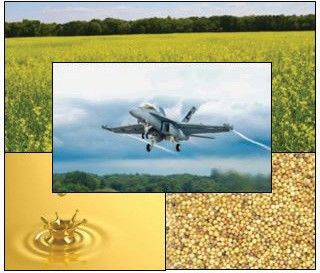
Credit: David Wright, UF/IFAS (field, seed); Thinkstock (oil); ARA (plane)
This publication’s “Agronomic Management” section provides recommendations based on research conducted at the University of Florida (UF) and other southeastern universities in Alabama, Florida, Georgia, South Carolina, and North Carolina over the past decade. Carinata hybrids are currently being tested at multiple locations throughout north Florida and the Southeast (Mississippi, Alabama, Georgia, South Carolina, and North Carolina) to identify frost-tolerant, high-yielding, early maturing, and nitrogen-use efficient varieties that are adapted to this region. Early harvest is an important agronomic consideration in double-cropping systems. When planted by mid-November and harvested in early May, carinata can be double-cropped without lowering the yields of subsequent crops. Other key management strategies to maximize yield include (1) chisel plowing followed by rolling or cultipacking to prepare a compact seedbed and (2) planting carinata in 14-inch rows using 5 lb of seeds per acre.
Preliminary findings suggest that carinata provides ecosystem services similar to other winter cover crops: reduces leaching and soil erosion, suppresses weeds, improves soil fertility (by adding organic matter to the soil), and provisions a food source for pollinators.
Carinata is agronomically superior to and more frost-tolerant than other oilseed crops and mustards. In north Florida, the crop produced 2,500 lb/acre, outperforming other brassica oilseeds from comparative field studies; canola and camelia produced 1,300 lb/acre and 850 lb/acre, respectively (George et al. 2021). Ethiopian custard also has relatively high oil content (more than 40%), a larger seed size, and lower lodging and shattering rates than other Brassica species. Though more heat- and drought-tolerant than canola, carinata prefers cooler temperatures, making it well-suited as a winter crop in the southeastern US.
The benefits of growing carinata as a winter crop are two-fold: (1) increased farmer revenue and (2) ecosystem services. Additionally, sowing carinata in the winter may retain soil moisture, increase soil organic matter, and reduce soil erosion and nutrient loss to water bodies, caused by leaching. Crop diversification also helps to control weeds and break disease and pest cycles. Carinata is not an invasive plant in the Southeast. Volunteer seedling emergence in subsequent crops is not an issue when normal site preparation and herbicides are applied for the summer crops. Producers, then, may have viable reasons to grow carinata after summer row crops .
Background
Carinata Characteristics
Carinata is high in erucic and linoleic acids and has less than 7% saturated fatty acids. These characteristics make it a non-food oil—too high in erucic acid (at approximately 36%)—but a desirable industrial oil. Since its 22-carbon chain can be cleaved into two biofuel hydrocarbons, the crop can be minimally processed into a high-quality drop-in biofuel. Thus, carinata has the potential to help meet renewable energy demands in the US and abroad without displacing feed and food crops.
Carinata Biology
In the early stages of growth, carinata resemble collards or mustard. Carinata, though, becomes highly branched and can grow as tall as 5 to 6 feet. At maturity, it resembles canola. An extensive deep root system, low canopy temperature, and thick, waxy leaves increase the plant’s tolerance to heat and drought. The taproots can reach 2 to 3 feet deep, with more than 50% of the root system in the upper 12 inches. In north Florida, the crop cycle ranges from 180 to 200 days (November to May), depending on variety, row spacing, temperature, and rainfall during seed maturation. When planted in early November in Quincy, FL, Nujet 400, the current commercial variety, has seedling emergence and establishment occur between 7 and 14 days after planting (DAP). First bolting occurs at 86 DAP, while 50% bolting occurs at 93 DAP. The first flower opens at 96 DAP with 50% flowering at 107 DAP. Flowering is completed at 136 DAP. Pod development and maturation occur between 136 and 170 DAP. Flowering and pod set start from the bottom and progress to the upper part of the inflorescence with subsequent seed maturation. Pods are 1.5 to 2 inches long, with an average of 10 to 16 seeds per pod and a 1,000-seed weight of 3.8 g.
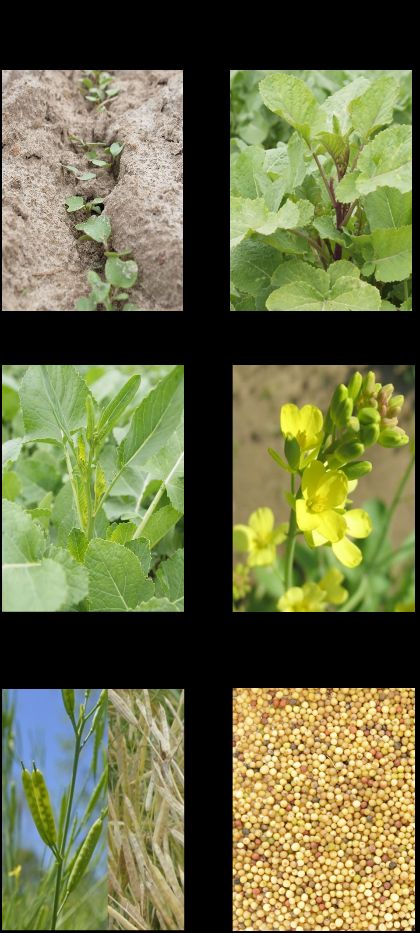
Credit: R. Seepaul, UF/IFAS
Agronomic Management
Nutrient Management
Soil tests are needed to determine the fertility status and pH of the fields where carinata will be grown. It is recommended to follow fertilizer recommendations for canola. Carinata grows best on well-drained soils with a pH between 5.5 and 6.5. In the absence of a soil test, the suggested fertilizer application would be—in lb/ac—80 N, 40 P2O5, 80 K2O, and 25 S for a yield goal of 30 to 40 bu/ac on loamy sands. Producers can supplement N on sandy soils with organic sources of N, such as poultry litter (refer to poultry litter section). Similar to N, S is important for protein synthesis. Unlike N, S is not mobile within the plant, so a continuous supply of S from seedling emergence to crop maturity is required for optimum growth and development. A deficiency of S at any growth stage can result in reduced yields. Split applications of N and S are recommended to avoid in-season deficiencies and excessive sulfate leaching. Avoid applying excessive N at planting since this will increase susceptibility to freeze damage.
For sandy loam soils, apply 20 to 30 lb N/ac, 10 to 15 lb S/ac, and all of the P and K fertilizers at planting. Apply the remaining N and S fertilizer at bolting. For sandy soils, a three-way split of N and S fertilizer is recommended to maximize nutrient uptake and minimize N leaching. At planting or emergence, apply 20 to 30 lb N/ac, 10 to 15 lb S/ac, 50% of the K, and all P fertilizer. Phosphorus may be applied and incorporated before planting. Apply 20 to 30 lb N/ac, 10 lb S/ac, and the remaining 50% K at bolting. The remaining N and S fertilizers should be applied at early flowering. Fertilizer can be broadcast and incorporated at planting, followed by topdress, sidedress, or by fertigation at bolting and flowering. Foliar applications may be used to address critical nutrient deficiencies but should be accompanied by a sound soil nutrient management plan.
Boron deficiency occurs in coarse, sandy soils with pH greater than 7.0, or during prolonged periods of drought. Use 1 lb B/ac as a pre-plant broadcast if the above conditions exist within a field. Foliar B applications of 0.5 lb B/ac will also alleviate B deficiencies.
Maximizing Poultry Litter Application for Optimizing Yield in Carinata
Tillage
Soil type and previous cropping history will influence the type of tillage necessary to prepare the seedbed: no-till or by ripper-roller. Carinata can be planted into minimally tilled soil, or it may be no-till planted in standing stubble, with little or no effect on seed yield. Tillage methods (conventional, no-till, ripper-roller, broadcast, and disk) do not influence seed yield under sandy loam soil conditions (Iboyi et al. 2021). To avoid early season stand losses due to ponding, one should rip at 45° to planting with a ripper-roller. Conservation tillage (i.e., non-inversion deep tillage or ripping), broadcasting, and disking may improve water conservation and increase soil organic matter, fuel efficiency, and erosion control. These forms of tillage are therefore promoted in the Southeast. If carinata is no-till planted into sod or other row crop fields, the previous crop residue should be reduced to minimum stubble height to allow for good seed-to-soil contact.
A fine and firm seedbed allows for good seed-to-soil contact, germination, and uniform emergence. If deep tillage is used (turning plow or chisel plow), the area may need to be firmed with a roller, allowing sufficient time for a rain, or one could, alternatively, irrigate with enough water to create a firm seedbed.
Variety Selection
Evaluations of advanced lines are ongoing; they will continue to identify high-yielding (seed and oil), disease-resistant, early maturing lines adapted to the Southeast US. According to evaluations throughout the past three years, yields ranged from 1750 to 2700 lb/ac. In plot studies, Nujet 400 matured in 170 to 180 days and produced approximately 2500 lb seed/ac (50 bu/ac).
Carinata evaluations in the 2021–2022 season identified promising hybrid lines with higher tolerance to cold weather, increased shatter resistance, and higher yield potential than the current commercial variety (Figure 3).
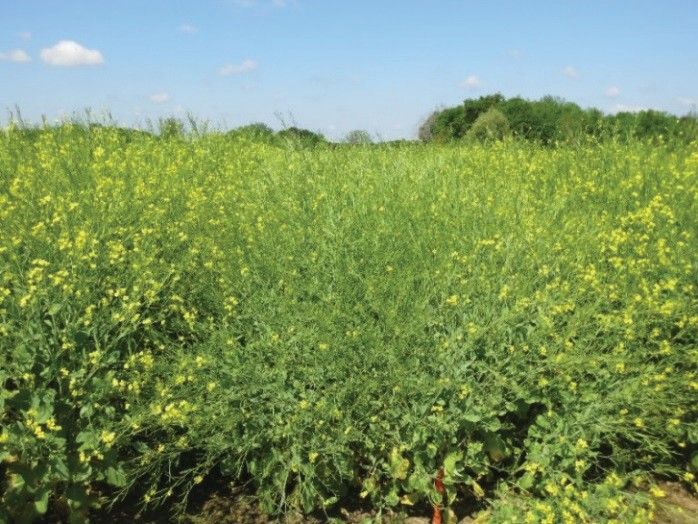
Credit: David Wright, UF/IFAS
Planting Considerations
Carinata will outcompete many winter weeds. However, including wild radish in the harvest may reduce carinata harvest value by decreasing oil quality. Therefore, one should identify fields with low weed pressure particularly from wild radish and wild mustard. These two weeds are likely to survive carinata registered herbicides, compete, and reduce yields.
Carinata is susceptible to residual herbicides, commonly used in peanut production such as Cadre (imazapic), Pursuit (imazethapyr), Classic (chlorimuron), and Strongarm (diclosulam). Hence, it is critical to consider the herbicide history of the field before planting. Herbicides used in cotton or peanut may reduce carinata establishment, growth, and yield. Most residual herbicides used in other summer rotational crops such as corn and soybeans should not represent a major risk for carinata establishment as long as they are applied early in the season and plant-back restrictions are met. Table 1 provides canola’s crop rotation restrictions for some of the most restrictive residual herbicides due to their persistence in the soil. This table may be used as a preliminary guide for carinata rotation intervals.
Planting Date
In the southeastern US, the crop is fall planted about 3–4 weeks before the first frost. In the Florida panhandle, southern Alabama, and southern Georgia, carinata should be planted between early to mid-November. Figure 4 highlights general planting windows for other regions in the Southeast. Planting outside the recommended window may incur a high incidence of freeze damage, reduced stand density, and reduced yield. Late plantings may result in increased pest damage and late harvest.
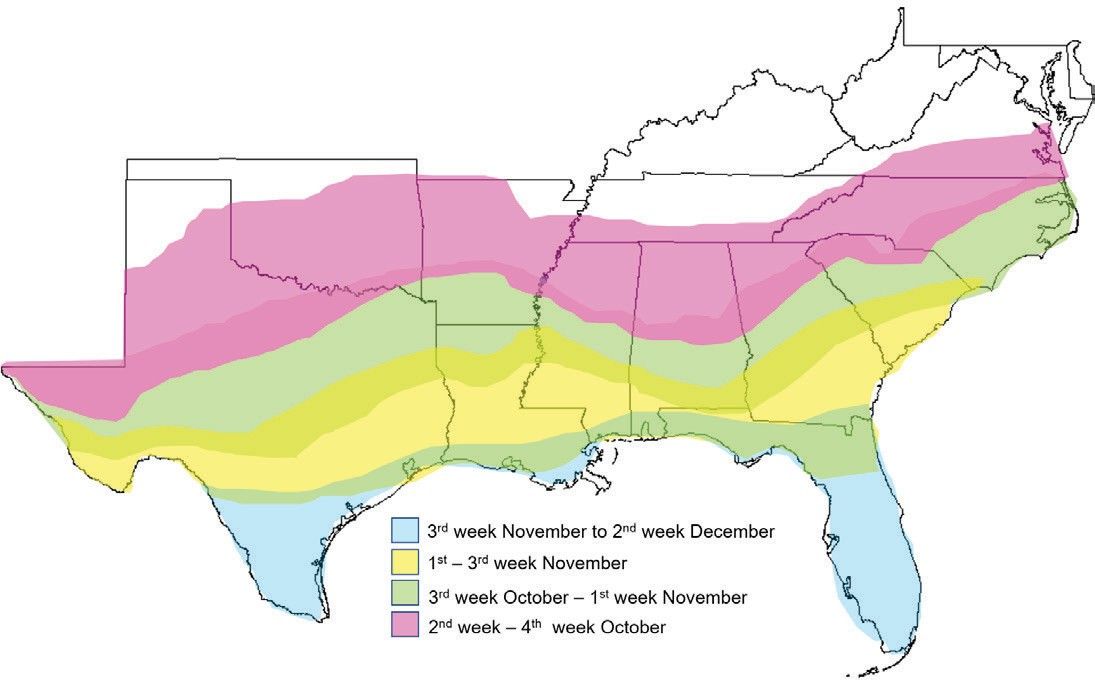
Credit: Nuseed
Seeding Depth
Carinata should be planted not more than 0.5 inches deep because of its small seed size. Some seed visible on the soil surface is normal and an indication that the planting depth is not too deep. That said, greater planting depths should be considered for sandy soils. Fields may be prepared with a drag attached to a cultivator frame to establish a level seedbed. Seed drills should be calibrated to ensure consistent seeding depth and rate.
Seeding Rate and Row Spacing
Carinata should be planted at 5 lb/ac (regardless of land preparation method) with a target end-of-season plant density of 6 to 10 plants per square foot. A lower seeding rate (4 lb/acre) is suggested if air or vacuum planters are used. Increased plant densities may reduce the number of days needed to reach maturity as well as reduce yield.
Row spacing, as shown in Figure 5, is a more important consideration than seeding rate (Mulvaney et al. 2018). From small plot research, row spacings of 7 to 14 inches will maximize yield, with a numerical yield advantage at 14 inches compared to 7 inches. Row spacing exceeding 14 inches lowers the crop’s ability to compete with weeds and significantly reduces yield.
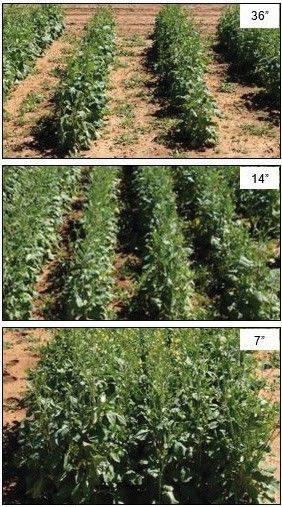
Credit: Ramon Leon, NCSU
Weed Management
One must start the season with a clean field. Because wild radish and wild mustard are the most problematic weeds in carinata, it is best to plant this crop in fields free of these weeds. Preplant burndown applications of postemergence herbicides with no residual activity such as carfentrazone, glufosinate, glyphosate, or paraquat are important—especially in no-till or reduced-tillage fields. These herbicides can be applied up to 7 days before planting. A preplant soil incorporated (PPI) application of a residual herbicide such as trifluralin or ethalfluralin will reduce weed pressure during the first 4 to 6 weeks of the growing season; this allows carinata ample time to establish itself and grow taller than the weeds.
Planting in narrow rows (preferably no more than 15 inches and no smaller than 7.5 inches) and using high seeding rates (at least 5 lb/acre) will favor rapid canopy closure and weed suppression. Carinata has wide leaves that can shade the ground and reduce weed emergence and growth. If you have weedy fields, limit your nitrogen fertilization at planting to the minimum recommended. This will reduce the number of weeds emerging with the crop (Figure 5).
Carinata is closely related to EPA Oilseed Crop Group 20 and Rapeseed Subgroup 20A. Permanent tolerances for several selective herbicides have been published for the Crop Group 20A in the Federal Register, which could be helpful for supporting regulatory approvals without additional residue research. Carinata tolerance to commercially available herbicides is currently being studied. There are several products available for weed control (Tables 2, 3, and 4). Check the label information for restrictions before and after planting carinata.
Currently, there are no selective herbicides for postemergence control of broadleaf weeds once carinata is established. However, grass herbicide products containing sethoxydim, quizalofop, and clethodim are safe to use on carinata and can help control grassy weeds. Some populations of perennial ryegrass have evolved resistance to these grass herbicides; for these, use PPI herbicides.
Tillage before planting can help eliminate weeds that could compete with the crop during emergence. Cultivation after carinata emergence can be done for wider row planting; however, it is not recommended for narrow rows to avoid crop damage.
Volunteer Carinata Control in Subsequent Crops
Preemergence application of herbicides from Group 15, such as Dual Magnum and Warrant, will not provide early-season volunteer carinata control in subsequent crops. However, carinata is highly sensitive to most other preemergence and postemergence herbicides applied on cotton, peanut, corn, or soybean. Therefore, volunteer carinata is not considered a major problem for these crops.
Disease Management
Carinata disease management is like that of canola and other mustards. Scouting for diseases is a necessary preventative measure. Like other Brassica crops, carinata should not be grown every year but once every three years on the same field to reduce disease problems. Fungicide trials to develop recommendations for carinata are still ongoing. Table 5 lists approved fungicides for carinata. The following subsections describe some diseases to scout for in carinata.
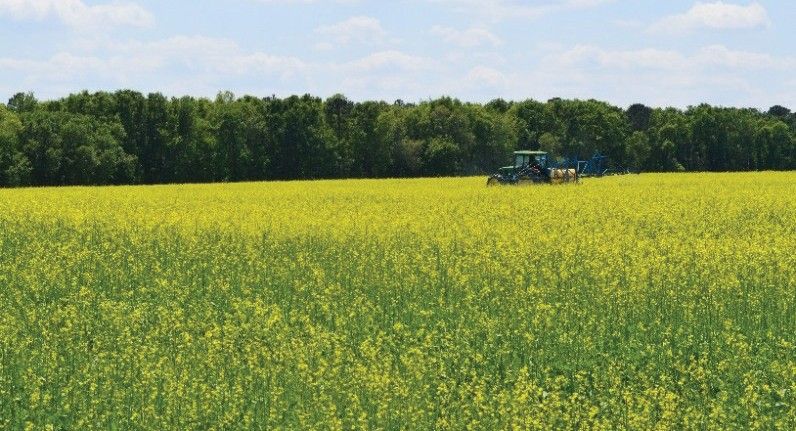
Credit: David Wright, UF/IFAS
Sclerotinia Stem Rot or White Mold
Sclerotinia stem rot, also known as white mold, is caused by Sclerotinia sclerotiorum, which may infect carinata at any stage of development. It grows well in wet environments, especially after prolonged rainfall or irrigation. Symptoms in the early stages include soft watery lesions or areas of very light brown discoloration on the leaves, main stems, and branches. Lesions expand, become greyish white, and may have faint concentric markings; under wet conditions, the fungus may produce white, fuzzy growth from infected tissue (Figure 7). Dark or brown stem lesions may also occur. When the stems of diseased plants are split open, hard black fungal resting bodies (sclerotia) may be seen. These structures may be about the size of a carinata seed or up to 0.8" long and oblong. Under some circumstances, these sclerotia and white moldy growth may occur on the outside of the plant. Sclerotinia may cause premature seed ripening, shrunken seeds, and shattering. Currently, it is not considered a serious problem in the southeastern US and should be manageable if proper rotation cycles are followed. If disease risk is sufficient to justify a fungicide application, the typical target window for application is between 20% to 50% bloom. If plants are damaged by (yet survive) cold temperatures, one should consider a preventative fungicide to protect the damaged plants from Sclerotinia sclerotiorum.
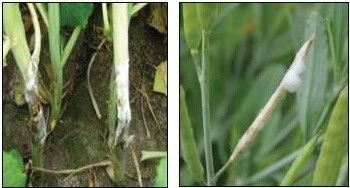
Credit: R. Seepaul, UF/IFAS
Alternaria Black Spot
Alternaria black spot is caused by a fungus (Alternaria spp.) that infects leaves, stems, and pods (Figure 8). Symptoms begin with small, dark, circular lesions or spots that expand if conditions are favorable and may lead to leaf drop.
Lesions can multiply rapidly and later spread to the upper leaves, stems, and pods. Stem and pod lesions first appear as small brown or black dots that may develop into conspicuous spots or longer and wider lesions of various shapes. Pod infection may cause seeds just beneath the black spots on the pods to be small, shriveled, and grey to brown. Infected pods may ripen prematurely and shatter while the crop is standing or being harvested. Alternaria is typically present every year, but the severity of the disease varies from year to year based on the suitability of the environment for the disease (temperature and humidity). Black spot epidemics begin to intensify at flowering and reach maximum intensity in the late stages of crop development. Currently, Alternaria is not considered a serious problem in Florida.
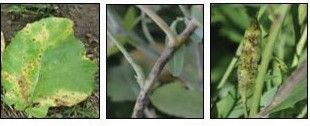
Credit: R. Seepaul, UF/IFAS
Fusarium spp.
Fusarium seed rot compromises seed quality by reducing oil content and test weight. Warm temperatures and extended periods of moisture promote infection and disease development at maturity. Plantings in November seldom have a problem if harvested in a timely manner; conditions become more favorable for Fusarium spp. with June harvests. The crop should be harvested as soon as seeds are at 10% moisture or less. Crop rotation is a particularly important part of disease risk reduction because Fusarium survives in crop residue.
Turnip Mosaic Virus
Turnip mosaic virus (TuMV) symptoms include mosaic or mottled patterns on leaves in broad, yellow, circular, and irregular areas (Figure 9). The disease may also cause distortion and stunting of plants. It survives in weeds or alternate host plants outside the growing season and is spread from these infected plants into crops by aphids. Wild radish is likely to be the most important weed host, but the virus does have a wide natural host range. And many weed species can act as reservoirs for infection. TuMV is transmitted by many aphid species. Fortunately, aphids are usually not as prevalent during periods of frost or cool weather in the winter, and late-season infections in spring are less likely to impact yield. To help manage this disease, try to control broadleaf weeds (especially over summer) to reduce this potential reservoir for the viruses.

Credit: R. Seepaul, UF/IFAS
Insect Management
Studies in the Florida panhandle have documented arthropod pests associated with carinata at different phenological stages during the winter/spring crop season; these studies indicated no significant differences in the occurrence of the pests across crop stages (Baldwin et al. 2021). The pests detected in carinata include adults and larvae of yellow margined leaf beetle, diamondback moth larvae, cabbage white butterfly larvae, spotted cucumber beetle adults, turnip aphid adults and nymphs, eastern leaf-footed bug adults, and tobacco budworm (Table 6; Figure 10). Pest surveys performed in commercial fields indicated that diamondback moth and yellow margined leaf beetle are the predominant insect species associated with carinata (Moore et al. 2018).
The relationship between pest injury and the impact of defoliation on B. carinata in the cultivar ‘Avanza64’ was measured (Figure 11). The numbers of pods per plant, seeds per pod oil concentration, erucic acid concentration, and yield were negatively impacted by defoliation during the vegetative and flowering stages. The yield reduction has been estimated at 0.32 and 0.12 bushels/acre, respectively, per 1% defoliation. Defoliation at the pod development stage does impact yield.
The recommendation is to sample the crop by plant inspection to detect initial infestation of pests. During the plant inspection, it is important to remember that the distribution of these pests within the carinata canopy is not uniform (Baldwin et al. 2021). Adults and larvae of turnip aphid, yellow margined leaf beetle adults and larvae, and diamondback moth larvae did not have a uniform plant canopy distribution. Larvae of cabbage white butterfly, eastern leaf-footed bug adults, spotted cucumber beetle, and tobacco budworm larvae are frequently observed in low densities, but there are no significant differences in plant canopy distribution.
Table 7 provides a list of insecticides registered for use on carinata. Check the label for restrictions.
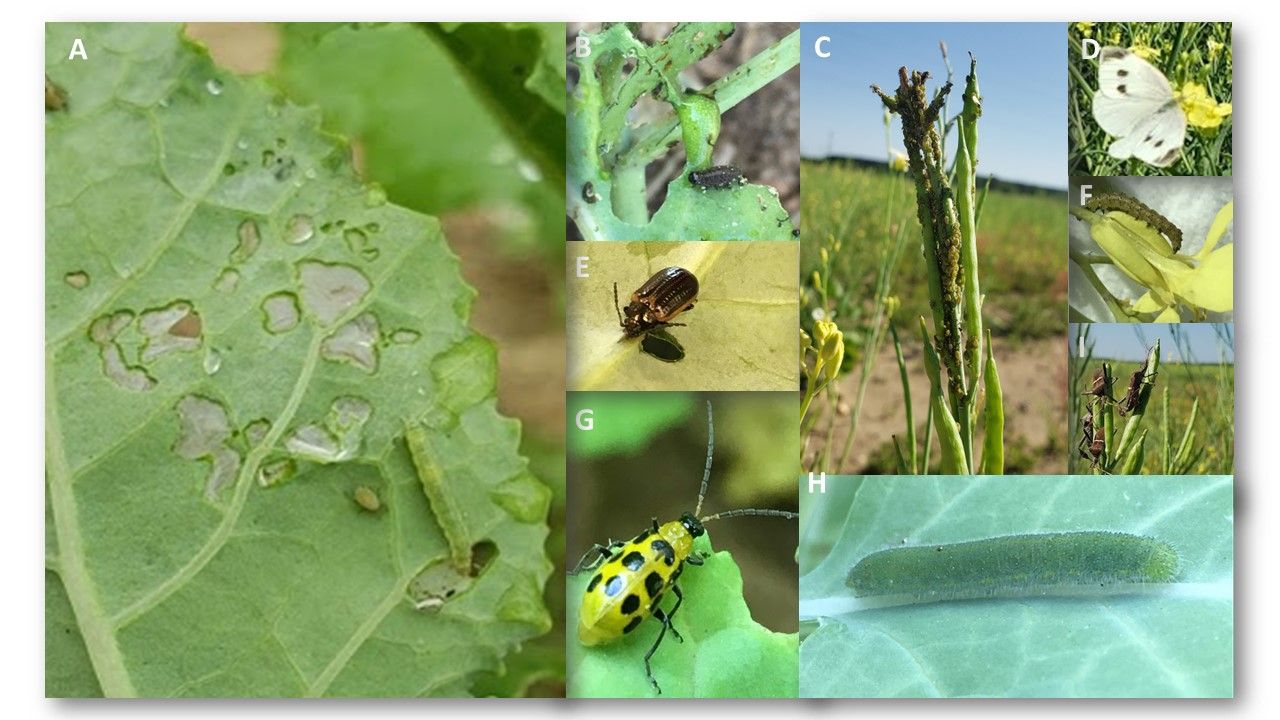
Credit: J. Baldwin, UF/IFAS
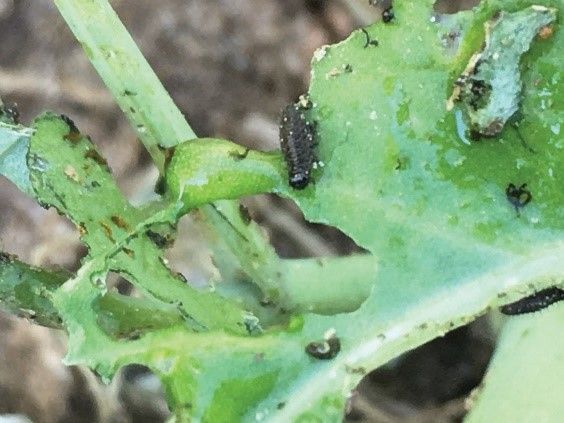
Credit: J. Baldwin, UF/IFAS
Harvest Management
Harvest aids are used to accelerate carinata harvest maturity, improve crop uniformity, and desiccate weeds and green tissue (pods, stems). Using harvest aids may also increase harvest efficiency and reduce potential shatter loss, which may or may not occur depending on the weather.
Carinata has a high level of resistance to pod shattering; however, timing, proper machine adjustments, and harvest methods are critical for optimum yield and quality. In the Southeast, harvest can be delayed due to continuous erratic wet periods in late spring. Green stems, weeds, and uneven ripening can also hinder optimum harvest. The application of harvest aids enables uniform crop ripening by drying down all green vegetative growth. To optimize yield and seed quality, the crop must be physiologically mature before harvest aids are applied.
Carinata seed is physiologically mature when the seed color changes from green to light green. Leaf, stem, or pod color change may not be predictors of physiological maturity. Normal seed desiccation progresses rapidly, indicated by a drop in moisture content from 50% to 10% in 4 weeks. A harvest aid can be applied when >70% of the seeds are physiologically mature. At this time, the upper branches and pods will be brown. The main stem may remain slightly green.
Harvest aids are suggested but not required. When deciding to use harvest aids, consider the crop maturity, field conditions, and environmental conditions before application. Carinata can be physiologically mature but may have green stems and pods that can interfere with the harvest operation. Weeds that are present at harvest may also interfere with harvesting. Apply harvest aids at maturity to desiccate carinata stems and weed foliage. Table 8 provides a list of desiccants registered for use on carinata. Check the label for restrictions.
Reglone (diquat dibromide) and Sharpen (saflufenacil) are labeled for use on carinata as harvest aid desiccants. Reglone is a contact herbicide that is activated by light reactions in the plant. When applied on sunny days, Reglone is activated as soon as the product comes in contact with the plant surface. One should apply Reglone in the evening or on cloudy days to allow the active ingredient to cover the plant surface for improved efficacy (quicker burn and dry down). The highest volume of water feasible will maximize efficacy (20 gallons/acre or more), but the herbicide will also work at lower rates.
Sharpen, a translocated herbicide, has a mode of action similar to Reglone’s. Like with the latter, carinata farmers should allow up to 7 days for optimum desiccation effect, depending on environmental conditions.
When the moisture content is <10%, carinata may be harvested using the machine settings and screens for rapeseed outlined in the harvester operator manual and fine-tuned for conditions in the field.
Optimized harvest methods will reduce seed loss that occurs at the combine header, via seed leaks, and during threshing, separating, or cleaning. To minimize harvest seed loss, monitor and quantify seed loss and adjust the harvester settings to crop and field conditions.
How to minimize harvest losses?
- The application timing of harvest aid should be optimized to minimize the loss of seed yield. Harvest aids should be applied early enough to avail the benefits of an early harvest but avoid overly early application that can result in shriveled seeds, decreased yield, and seed quality. A harvest aid can be applied when >70% of the seeds are physiologically mature.
- The weather forecast and condition of the crop are important factors to consider when applying harvest aids. Harvest aids will need about 7 days–10 days to be effective. Plan on harvesting as soon as the seed moisture is at 10% or less. Seeds will deteriorate if allowed several cycles of wetting and drying.
- Use the machine settings for rapeseed outlined in the operator’s manual. Settings will have to be adjusted and fine-tuned depending on crop moisture and harvest conditions. It is essential to have the proper screens and combine settings to reduce dockage and loss of seed. An example of an average recommended John Deere S-Series Combine setup for canola is:
- Feederhouse chain speed: 26T
- Feederhouse drum down
- Feed accelerator on high speed
- Serratedfeedacceleratorwearstrips
- Backshaft speed: 510 rpm / 1st gear 5 speed
- Cleaning fan speed: 750 rpm, 600–900 working range
- Rotor speed: 450 rpm, 350–550 working range
- Concave clearance: 20, 15–40 working range
- General purpose chaffer: 13mm, 10 mm–14 mm working range
- High performance chaffer if equipped: 12 mm–16 mm + increase fan to 100 rpm
- Dual zone chaffer: manual adjust 5 mm on level land/10 mm on hills
- General purpose sieve: 3 mm, 2–5 working range
- Match reel speed with ground speed. Set fingers straight up and down to minimize wrapping.
4. Cut carinata as high as possible, just below the seed pods, to minimize the amount of biomass to be threshed. Pulverized high moisture residue or straw may fall onto the sieves, reducing the air flow and separation and increasing the seed loss.
5. Check periodically for seed loss and adjust combine settings for optimized harvest.
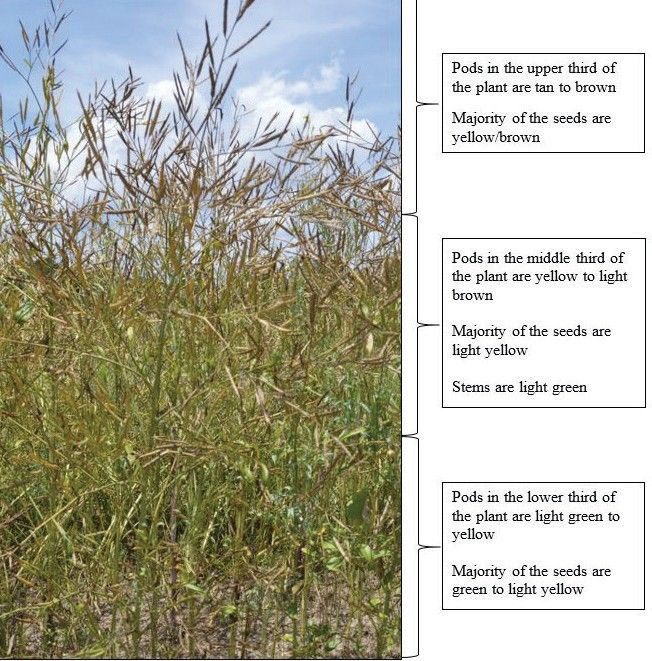
Credit: R. Seepaul, UF/IFAS
Carinata as a Winter Crop in SE Rotations
Carinata has shown significant promise for southeastern producers by providing additional cash flow and cover crop benefits. Double cropping with winter carinata is more profitable than producing a single crop per year. Carinata is grown every third year on the same field and can be planted after corn, cotton, peanut, or soybean. The 6-month cycle of carinata may delay the planting of summer crops until May. In a study that rotated carinata, oats, or fallow in the winter with summer corn, cotton, peanut, or soybean, the inclusion of carinata in the cropping system did not influence the performance of soybeans. This suggests that soybean can be successfully double-cropped, resulting in both economic and environmental benefits for producers in the region. Economic modeling also indicated rotations that include carinata and soybean were more profitable than winter fallow. Similar field studies have also demonstrated that sorghum can be grown after carinata. SPARC (refer to “SPARC: Southeast Partnership for Advanced Renewables from Carinata” section below) is currently screening for early‐maturing varieties to improve carinata fit in the double‐cropped peanut-cotton rotations prevalent in the region. The team is also researching a suite of complementary agronomic best practices, such as nutrient management and the use of harvest aids, that would allow for the integration of carinata into SE rotations.
Single-cropped corn, cotton, and peanut outperformed double-cropped corn, cotton, and peanut. Soybean performance did not differ between cropping systems. Opportunities exist to modify practices to reduce delay in the planting of summer crops after carinata harvest (use of earlier maturing carinata varieties, seeding carinata into standing row crop residue). Fallowing has environmental costs. Opportunities exist to quantify the environmental benefits of double cropping with a winter cover crop (reducing nutrient leaching, erosion, building soil health). Future use of hybrid carinata that are cold and disease tolerant and higher yielding may increase the profitability of double-cropped systems. Carinata’s profitability can be further enhanced by farmers adopting sustainable practices.
Value of Carinata in Cropping Systems
When grown as a winter crop in the Southeast, carinata provides ecosystem services such as improved soil and water quality, improved soil fertility, and pest reduction. Carinata is a high residue crop that returns to the soil and accumulates over 7000 lb of dry matter per acre per year. The decomposition and mineralization of this biomass can improve soil quality and fertility. Carinata is a nutrient scavenger. One study found that when 90 lb N and 78 lb K were applied per acre per year, 107 lb N per acre and 97 lb K per acre were removed from the seed and biomass. About 35 lb N and 85 lb K per acre are returned in the straw. Recycling residual nitrates through the biomass helps reduce nutrient leaching and runoff and makes some of those nutrients available for the following cash crop. Carinata increased water infiltration by 70%, reduced soil erosion and plant growth, and increased nutrient cycling. Relative to a fallowed system, double-cropping carinata with corn and cotton reduced leaching by 23% and 42%, respectively, while a corn or cotton crop followed by winter fallow increases the nitrate leaching by 75% and 70%. Carinata can also reduce total sediments, mineral phosphorus, and nitrate loads from 11.5% to 50.0% in surface runoff. In addition to improving soil and water quality, carinata reduced the emergence of smooth pigweed within the growing season as well as in the subsequent summer crop. Plant-parasitic nematodes were greater in the rotations that had no winter cover crop. Carinata could be considered as a crop to manage reniform nematodes without causing damage to free-living populations. Pollinators can also benefit from carinata’s early flowering time in February and March, when food sources are scarce in the region. The crop can support pollinators with floral resources leading to the stabilization of insect communities. It also provides significant value to cropping systems in which double cropping with winter carinata proved more profitable than producing a single crop per year.
Services Agreement for Nuseed Carinata Contract Production
Nuseed manages the closed loop contract system that commercially produces Nuseed Carinata. Nuseed authorized distributors/agents to make the seed available to growers that have completed the Services Agreement for Nuseed Carinata Contract Production. Contract production documentation validates Nuseed Carinata as a sustainably and ethically produced feedstock that provides market access in rapidly expanding renewable energy markets. Fertilizer application rate, type of fertilizer, herbicide type, and rate and planting rate are a few examples of the documentation required. Complete requirements are outlined in the contract. These credentials are increasingly important to low-carbon fuel processors’ energy market goals and to their end customers.
All contracted acres are to be harvested with the grain segregated and stored separately to preserve identity. The grain is picked up on farm or delivered to a Nuseed designated collection facility as indicated in individual contracts. Nuseed facilitates any further transport required to select processors.
If a contract grower determines the crop is not harvestable, they are to contact their Nuseed Carinata agent to confirm the process for contract termination.
Closed Loop Contract
The closed loop contract system used for commercial production of Nuseed Carinata outlines the annual contract price per bushel and freight; these prices will vary by year and region. Additional opportunities rewarding the adoption of specific sustainable farming practices are detailed within the contract.
An important economic factor is that cover crops, including the harvested cover crop Nuseed Carinata, have recognized soil benefits. Erosion protection, nutrient uptake, moisture retention, weed suppression, soil decompaction, and carbon sequestration are all potential benefits credited with improving aspects of soil health and resiliency for improved production conditions for the next season’s crops (https://www.sare.org/publications/managing-cover-crops-profitably/benefits-of-cover-crops/).
A Nuseed Carinata contract enables growers to cover the cost of improving and protecting their soil with a cover crop, plus earn contract payment for sustainable farming practices and the harvested grain.
Crop Insurance
This information is from the USDA Risk Management Agency (RMA) office and provided here for summary purposes only. Please contact your local insurance agent for confirmation prior to contracting. Nuseed Carinata is a cover crop with a harvested oilseed, and the biomass is not recommended to be grazed, hayed, or removed from the field.
Double cropping rules are mandated by the Federal Crop Insurance Act (Act). A producer may receive a full indemnity or a full prevented planting payment for two or more crops planted for harvest on the same acreage in the same crop year in accordance with the double cropping provisions contained in section 508A(d) of the Act, and section 15(h) of the Common Crop Insurance Basic Provisions (Basic Provisions). The RMA Loss Adjustment Manual is the loss adjustment procedure for the rules in the Basic Provisions set forth by the Act. A producer can qualify for double cropping if each of the following conditions are met:
- It is a practice that is generally recognized by agricultural experts or the organic agricultural industry in the area to plant two or more crops for harvest in the same crop year.
- The secondary, tertiary, etc. crops are customarily planted after the first insured crop for harvest on the same acreage in the same crop year in the area.
- Additional coverage insurance offered under the authority of the Act is available in the county for the two or more crops that are double cropped.
- The producer provides records acceptable to the approved insurance provider of acreage and production. These records must show that (1) the producer has double-cropped acreage in at least two of the last four crop years in which the first insured crop was planted or (2) the applicable acreage was double-cropped in at least two of the last four crop years in which the first insured crop was grown.
If a producer does not meet the double-cropping requirements listed above, the producer may still insure both their first crop and a second crop of carinata. If the producer is prevented from planting the first insured crop or suffers a payable loss on a first insured crop and the producer does not have double cropping history, the producer is subject to the first/second crop rules in section 15(e) of the Basic Provisions.
If the producer’s first insured crop is prevented from planting, the producer can:
- Decide not to plant a second crop (as defined in the Basic Provisions) and receive a full prevented planting payment on the first insured crop.
- Plant and hay or graze a cover crop on or after November 1 and receive a full prevented planting payment on the first insured crop.
- Plant a second crop or hay or graze a cover crop after the late planting period for the first insured crop. This must be done before November 1 for the producer to receive a 65% reduction in prevented planting payment. The producer will also have to accept a yield of 60% of actual production history (APH) for the year to be counted as part of their APH.
If the producer’s first insured crop is planted and fails and it is not practical to replant the first insured crop, the producer has the following options:
- Opt against planting a second crop, or plant and do not insure a second crop to receive a full indemnity for the first insured crop.
- Plant and insure a second crop, receive a 65% reduction in indemnity for the first insured crop, and pay 35% of the premium for the first insured crop.
- Receive the remaining 65% of indemnity on the first insured crop—if there is no loss on the second crop—and pay the full premium on the first insured crop. If the second crop receives an indemnity, the first crop indemnity would remain at 35% and the second crop indemnity would be paid in full with no reduction.
SPARC: Southeast Partnership for Advanced Renewables from Carinata
SPARC is a collaboration of regional land grant universities and industry partners representing subject matter experts in basic and applied research, Extension, outreach, and workforce development. The three pillars of research, Extension, and workforce development collaboratively support carinata as a viable winter crop in the southeastern US, resulting in carinata-centered advanced renewables and coproduct supply chain in the region with national and global impact. SPARC has a twofold mission. It removes physical, environmental, economic, and social constraints of regional carinata production as a renewable fuel, bioproducts, and coproducts feedstock, and it ensures stable markets for jet fuel and bioproducts through demonstration of enhanced value across the supply chain. This mission aligns with USDA’s focus of delivering regionally appropriate sustainable biomass feedstock to produce alternative jet fuel in supply chain systems that may be linked to facilities near civilian or military aviation hubs.
Carinata has emerged at the forefront of advanced biofuel alternatives thanks to the collaborative work of the University of Florida (UF); Nuseed, holder of the world’s most extensive carinata germplasm collection; and Applied Research Associates (ARA), a chemical engineering company with a patented catalytic hydrothermolysis (CH) technology for conversion of carinata oil into drop-in bio-jet and bio-diesel fuels. Their work has made the crop alternative competitive with petroleum.
For more information, visit SPARC’s website.
Summary
Establishing carinata as a winter cash crop on underutilized or fallow land will increase diversification, generate revenue, and improve conservation of nitrogen and water, reducing input costs and increasing the sustainability of farming systems.
References
Baldwin, J. M., S. V. Paula-Moraes, M. J. Mulvaney, and R. L. Meagher. 2020. “Occurrence of Arthropod Pests Associated with Brassica Carinata and Impact of Defoliation on Yield.” Global Change Biology Bioenergy, 13: 570–581. https://doi.org/10.1111/gcbb.12801.
George, S., R. Seepaul, D. Geller, P. Dwivedi, N. DiLorenzo, R. Altman, E. Coppola, et al. 2021. “A Regional Inter-Disciplinary Partnership Focusing on the Development of a Carinata- Centered Bioeconomy.” Global Change Biology Bioenergy, 13: 1018–1029. https://doi.org/10.1111/gcbb.12828.
Iboyi, J. E., M. J. Mulvaney, K. S. Balkcom, R. Seepaul, M. Bashyal, D. Perondi, R. G. Leon, et al. 2021. “Tillage System and Seeding Rate Effects on the Performance of Brassica carinata.” Global Change Biology Bioenergy, 13 (4): 600–617. https://doi.org/10.1111/gcbb.12809.
Mulvaney, M. J., R. G. Leon, R. Seepaul, D. L. Wright, D. L., and T. L. Hoffman. 2019. “Brassica carinata Seeding Rate and Row Spacing Effects on Morphology, Yield, and Oil.” Agronomy Journal, 111: 528–535. https://doi.org/10.2134/agronj2018.05.0316.
Protection to Environment. 2016. 40 C.F.R. 180.1. Accessed February 22, 2016. http://ow.ly/YC66T.
Silveira, M. L. 2014. “Soil and Plant Tissue Testing: SL412/SS625, 4/2020.” EDIS 2020 (2). https://edis.ifas.ufl.edu/ss625.
SPARC. Carinata Scouting Guide. https://sparc-cap.org/wp-content/uploads/2020/02/scouting_v2_web.pdf.
Wright, D. L. 2010. “Production of Biofuel Crops in Florida: Canola, SS AG296, 11/2010.” EDIS 2010 (6). Accessed September 9, 2014. http://ufdcimages.uflib.ufl.edu/ IR/00/00/37/32/00001/AG30100.pdf.
Table 1. Crop rotation restrictions of some commonly used herbicides for canola based on product label guidelines. Always read and follow label instructions before use.
Table 2. Herbicides for weed control (pre-plant burndown). Contact weed specialist Ramon Leon, Department of Crop and Soil Sciences, North Carolina State University: rleon@ncsu.edu. Always read and follow label instructions before use.
Table 3. Herbicides for weed control (preplant incorporated or pre-emergence). Contact weed specialist Ramon Leon, Department of Crop and Soil Sciences, North Carolina State University: rleon@ncsu.edu. Always read and follow label instructions before use.
Table 4. Herbicides for weed control (post-emergence). Contact weed specialist Ramon Leon, Department of Crop and Soil Sciences, North Carolina State University: rleon@ncsu.edu. Always read and follow label instructions before use.
Table 5. Fungicides for plant disease control. Contact: Plant pathology specialist Ian Small, UF/IFAS North Florida Research and Education Center: ismall@ufl.edu. Always read and follow label instructions before use.
Table 6. Occurrence and relative abundance of insects associated with carinata in the Florida panhandle during winter/spring crop seasons, Jay, FL.
Table 7. Insecticides for insect pest control. Contact insect specialist Isaac Esquivel, UF/IFAS North Florida Research and Education Center: Isaac.Esquivel@ufl.edu. Always read and follow label instructions before use.
Table 8. Herbicides for pre-harvest desiccation. Contact weed specialist Ramon Leon, Department of Crop and Soil Sciences, North Carolina State University: rleon@ncsu.edu. Always read and follow label instructions before use.